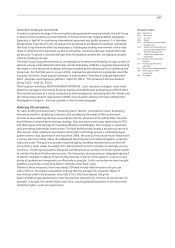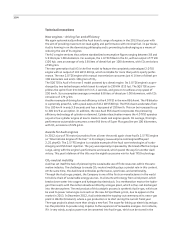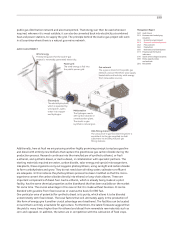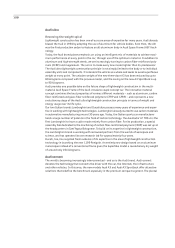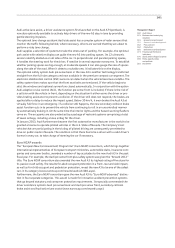Audi 2012 Annual Report Download - page 151
Download and view the complete annual report
Please find page 151 of the 2012 Audi annual report below. You can navigate through the pages in the report by either clicking on the pages listed below, or by using the keyword search tool below to find specific information within the annual report.
154
Technical innovations
New engines – driving fun and efficiency
We again systematically refined the Audi brand’s range of engines in the 2012 fiscal year with
the aim of providing maximum on-road agility and performance with minimal fuel. In particular,
Audi is homing in on the downsizing philosophy and is promoting turbocharging as a means of
reducing the size of its engines.
The A1’s engine versions thus achieve standardized consumption figures ranging between 3.8 and
5.9 liters per 100 kilometers. For example, the 1.6 TDI fitted in the A1, with an output of 77 kW
(105 hp), uses an average of only 3.8 liters of diesel fuel per 100 kilometers, with CO2 emissions
of 99 g/km.
The new-generation Audi A3 is the first model to feature the completely redeveloped 2.0 TDI
engine with an output of 110 kW (150 hp), which is notable for more than just its sporty perfor-
mance. The new 2.0 TDI engine with manual transmission consumes just 4.1 liters of diesel per
100 kilometers and emits 106 g/km of CO2.
The SQ5 TDI is Audi’s first-ever S model powered by a diesel engine. Its 3.0 TDI engine is super-
charged by two turbochargers which boost its output to 230 kW (313 hp). The SQ5 TDI accom-
plishes the sprint from 0 to 100 km/h in 5.1 seconds, and goes on to achieve a top speed of
250 km/h. Its consumption averages a modest 6.8 liters of diesel per 100 kilometers, with CO2
emissions of 179 g/km.
Another example of driving fun and efficiency is the 4.0 TFSI in the new RS 6 Avant. The V8 biturbo
is supremely powerful, with a peak output of 412 kW (560 hp). The RS 6 Avant accelerates from
0 to 100 km/h in only 3.9 seconds and has a top speed of 250 km/h. This can be increased to up
to 305 km/h as an option. In addition, the new Audi RS 6 Avant incorporates the pioneering
efficiency technology of cylinder on demand. Cylinder deactivation means the 4.0 TFSI operates
as just a four-cylinder engine at low to medium loads and engine speeds. On average, this high-
performance automobile consumes a mere 9.8 liters of Super Plus gasoline per 100 kilometers,
with CO2 emissions of 229 g/km.
Awards for Audi engines
In 2012 a jury of 76 motor journalists from all over the world again chose Audi’s 2.5 TFSI engine
as “International Engine of the Year” in its category (www.ukipme.com/engineoftheyear/
2_25.php#2). The 2.5 TFSI engine is a notable example of the Audi core technologies of turbo-
charging and FSI direct injection. The jury was especially impressed by the broad effective torque
range, along with the engine’s performance and sound, which paved the way for another Audi
victory. This year’s defense of the title was the eighth successive win for Audi TFSI technology.
CO2-neutral mobility
Audi has set itself the task of pioneering the sustainable use of finite resources within the auto-
motive industry. The challenge to create CO2-neutral mobility plays a pivotal role in this context.
At the same time, the Audi brand embodies performance, sportiness and emotionality.
Through the Audi e-gas project, the Company is one of the first car manufacturers in the world
to build a chain of sustainable energy sources. It all starts with energy from wind power, which
breaks down water into oxygen and hydrogen by electrolysis. In a methanation reactor the hydro-
gen then reacts with the carbon dioxide emitted by a biogas plant, which is thus not discharged
into the atmosphere. The end product of this catalytic process is synthetic Audi e-gas, which can
be used to power natural-gas cars such as the new A3 Sportback g-tron, due to appear on the
market in 2013. In December 2012, Audi celebrated the topping-out ceremony at its new e-gas
plant in Werlte (Emsland), where e-gas production is to start during the current fiscal year.
The e-gas project is about more than simply a new fuel. The scope for linking up electricity and gas
has the potential to provide a big impetus to the expansion of renewable energies. For instance,
if it is very windy, surplus power can be converted into Audi e-gas, which can be stored in the





